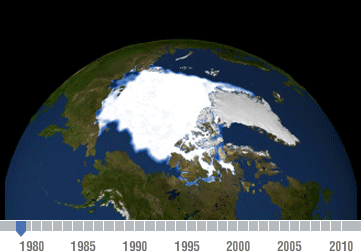20 May 2014
New research questions emerge from Arctic melting
Posted by abranscombe
By Alexandra Branscombe

“The Arctic in the Anthropocene: Emerging Research Questions” was released in April as an effort by the National Research Council to help chart the course of future research in the region as it goes through rapid change in the area.
Credit: National Research Council
WASHINGTON, DC – What is hidden within and beneath Arctic ice? Why does winter matter? What is being irretrievably lost as the Arctic changes?
These are just some of the emerging questions that scientists are being challenged to answer about the rapidly changing Arctic in a new report, “The Arctic in the Anthropocene: Emerging Research Questions,” released last month by the National Research Council’s Committee on Emerging Research Questions.
The report focuses on questions sparked by recent discoveries about the Arctic and new tools available to investigate the region, said Henry Huntington, an Arctic scientist with the Pew Charitable Trusts in Eagle River, Alaska, who co-chaired the report. Huntington spoke during an April 29 webinar announcing the report, which was written by an international committee of Arctic experts and scientists.
The report’s authors hope to inspire a wave of scientific research that is better equipped to study the changing Arctic. Interest in the region is rising as it undergoes rapid transformations as a result of global warming, they said.
For example, future research should tackle the “Hidden Arctic” – areas of the Arctic that have not been studied because they couldn’t be reached, but are now accessible because glaciers and other ice are melting. Researchers should also explore what is being irretrievably lost as the Arctic changes, including the threat that melting permafrost and ice pose to archeological sites and rare habitats, the report said.
“Our focus was on emerging research questions, distinguished from existing questions that have been asked for a while,” Huntington said. “Existing questions deserve continued attention … The focus on our task is to ask emerging questions on newly recognized phenomena, build on recent results, or on new technology that allows us to do things we couldn’t before.”
Scientists have a lot to sink their teeth into as the Arctic changes, Huntington said, including vanishing sea ice, retreating glaciers, melting permafrost, and the rippling global ecological effects that come with these scenarios.
“The Arctic is increasingly connected to the rest of the world,” Huntington noted. “Whatever happens in the Arctic does not stay in the Arctic.”
Research questions should also not be limited to one field of study, according to the report. New research needs to draw from various scientific disciplines, like anthropology and geoscience, and also include investment from public sources and private industry, the report’s authors said.

This time series from NASA satellites show Arctic sea ice declining from year to year at a rate of 11.5 percent per decade. A new report published by the National Research Council calls for more international and interdisciplinary research strategies to tackle emerging questions in the Arctic.
Credit: NASA/Goddard Scientific Visualization Studio
Huntington said interdisciplinary or international Arctic research that is happening now is not well coordinated. Instead, there should be better systems in place to connect researchers, investors, and the public.
The report also highlights the role humans play in the Arctic, explained Stephanie Pfirman, a professor of environmental science at Barnard College in New York City, and a co-chair of the report. Using the term “Anthropocene” – a geological time period defined by the impact humans have had on the Earth – in the report’s title encompasses not only the influence humans have had on the Arctic, but also our ability to research this part of the planet, she said.
“We wanted to highlight that as human capacity grows, our ability to do research also grows,” said Pfirman.
– Alexandra Branscombe is a science writing intern in AGU’s Public Information department










 GeoSpace is a blog on Earth and space science, managed by AGU’s Public Information staff. The blog features posts by AGU writers and guest contributors on all sorts of relevant science topics, but with a focus on new research and geo and space sciences-related stories that are currently in the news.
GeoSpace is a blog on Earth and space science, managed by AGU’s Public Information staff. The blog features posts by AGU writers and guest contributors on all sorts of relevant science topics, but with a focus on new research and geo and space sciences-related stories that are currently in the news.